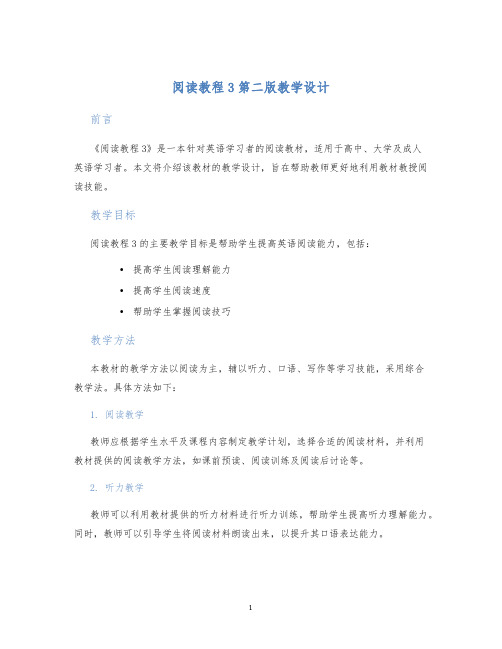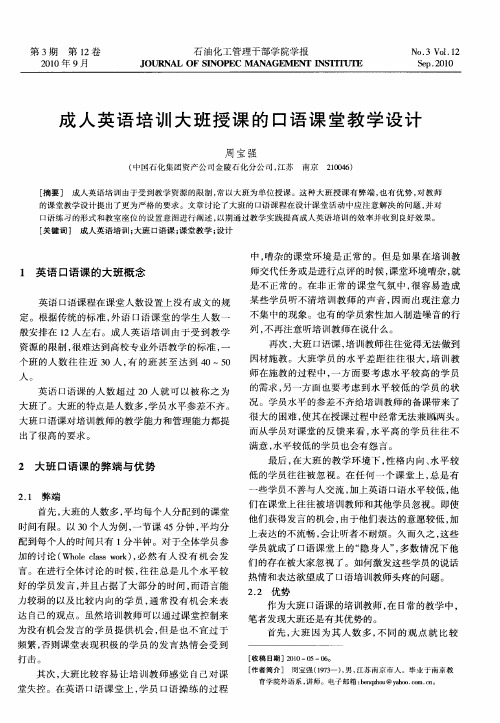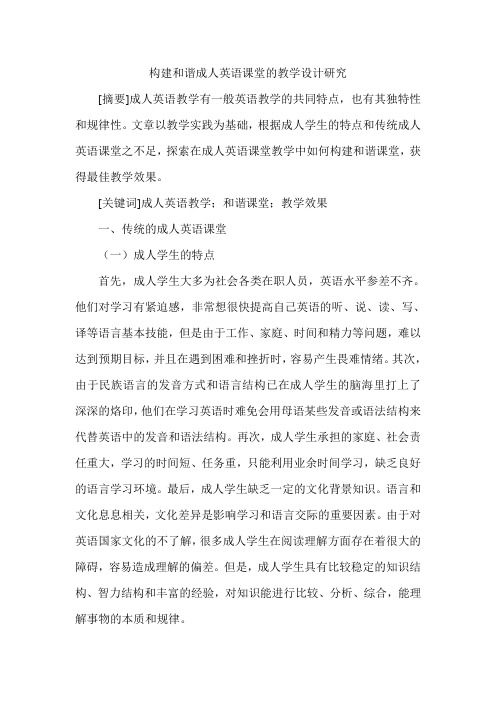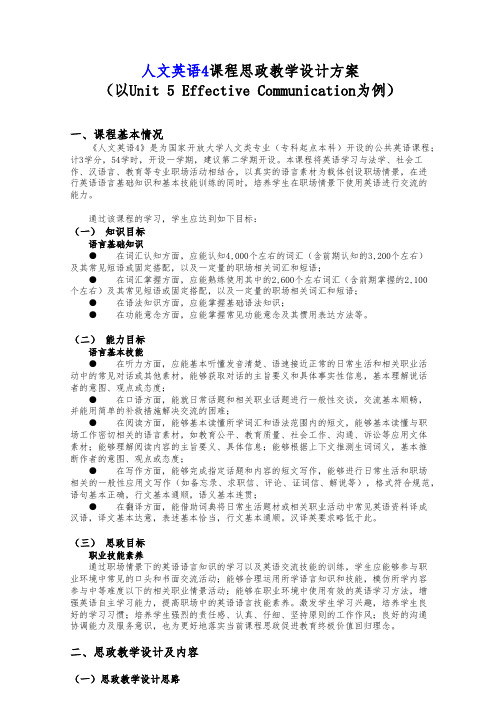成人英语教学设计教案
阅读教程3第二版教学设计

阅读教程3第二版教学设计前言《阅读教程3》是一本针对英语学习者的阅读教材,适用于高中、大学及成人英语学习者。
本文将介绍该教材的教学设计,旨在帮助教师更好地利用教材教授阅读技能。
教学目标阅读教程3的主要教学目标是帮助学生提高英语阅读能力,包括:•提高学生阅读理解能力•提高学生阅读速度•帮助学生掌握阅读技巧教学方法本教材的教学方法以阅读为主,辅以听力、口语、写作等学习技能,采用综合教学法。
具体方法如下:1. 阅读教学教师应根据学生水平及课程内容制定教学计划,选择合适的阅读材料,并利用教材提供的阅读教学方法,如课前预读、阅读训练及阅读后讨论等。
2. 听力教学教师可以利用教材提供的听力材料进行听力训练,帮助学生提高听力理解能力。
同时,教师可以引导学生将阅读材料朗读出来,以提升其口语表达能力。
3. 写作教学教师可以以本教材为基础,设计写作任务,如就读文章写一篇读后感、写一篇文章总结等等,以帮助学生掌握英语写作技巧。
教学内容《阅读教程3》共包含8个单元,每个单元安排了不同主题的文章,以满足学生不同水平的需求。
教师应根据具体情况选择适当的单元进行教学。
下面为单元主题与文章内容的简要介绍:单元一:文化差异本单元主要介绍文化差异,包括不同国家、不同文化之间的差异。
文章主题涵盖了饮食、服饰、方式等方面。
单元二:人物传记本单元主要介绍一些历史上或当代的重要人物,如科学家、文学家、艺术家等,有些文章也会介绍人物所处的时代背景。
单元三:环保本单元主要介绍环保意识及环境污染的历史、原因、影响等方面。
文章主题涵盖了垃圾处理、空气污染、气候变化等方面。
单元四:社会发展本单元主要介绍各个领域的发展,如科技、医疗、经济等方面。
文章主题涵盖了机器人、基因技术、金融危机等方面。
单元五:健康与运动本单元主要介绍健康和运动的相关话题,包括如何保持身体健康、如何进行适当的运动、如何预防疾病等。
单元六:旅游本单元介绍旅游与文化,包括各国旅游景点、不同的旅游方式、文化之旅等。
人教版英语七上教案7篇

人教版英语七上教案7篇人教版英语七上教案篇11.能听说、认读eye, face , ear, nose, mouth, 这些关于身体部位的单词,并能用英语介绍自己身体的这几个部分2.初步了解表示接触的指示用语,能听懂,并按指令做出相应的动作。
3..激发学生学习兴趣,培养听说习惯和能力。
教学重点:关于头部的单词eye, face , ear, nose, mouth的学习。
教学难点:eye, face 两个单词的元音因素容易发音不到位,教师可鼓励学生张大口型,相互检查。
mouth 一词的尾音发音较难,教师可适当提醒学生,注意口型教学过程:step 1.warm up and revi-sion1.greetings : hello,boys and girls! nice to meet you! sit down please! step2.presentation1. 利用多媒体展示学生感兴趣的动画人物“大耳朵图图”,让学生与图中人物进行口语交流let’s say “hello, tutu.”2.tu tu is so cute.look! this is tutu’s eye.并指着tutu的眼睛介绍。
同时引出新单词eye.a.先让学生倾听录音怎么读单词eye b.再范读教新单词eye(开火车读) c.让学生拼写这个单词e-y-e d.老师借助肢体语言,指着自己的眼睛说:this is my eye e.let’s do.follow me: eye eye 唰唰唰(跟着老师一起做动作).3.用同样的方法依次新授新单词:face、ear、nose、mouth4.powerpoint制作:打开幻灯片后每点击一身体部位就会出现相应的单词。
(注mouth一词的尾音发音较难,适当提醒学生,注意口型。
)5.认读face、ear、eye、nose、mouth的单词卡片和图片。
step3:practice1.let’s do: eye eye 唰唰唰ear ear 呼呼呼nose nose 闻闻闻mouth mouth 巴巴巴face face 拍拍拍2.i say you do.(老师说,学生快速做相应的动作,然后找一位学生出来做出动作。
新视野大学英语自编教案

新视野大学英语自编教案一、教材分析本课选自新视野大学英语第二版第三册,主题为“Body Language”。
本篇文章通过介绍身体语言在不同文化背景下的差异,帮助学生了解和掌握身体语言的基本知识,提高跨文化交际能力。
本文内容丰富,语言简单易懂,适合大学生学习。
二、教学目标1. 知识目标(1)了解身体语言的基本概念及其在不同文化背景下的差异。
(2)掌握表示同意、拒绝、焦虑、自信等身体语言的表达方式。
(3)学会运用身体语言进行有效的沟通和交流。
2. 能力目标(1)提高学生的英语听力、口语、阅读和写作能力。
(2)培养学生的跨文化交际意识,提高跨文化交际能力。
3. 情感目标(1)激发学生对身体语言的兴趣,增强学习英语的积极性。
(2)培养学生尊重不同文化背景下的交流方式,增强团队协作精神。
三、教学重难点1. 教学重点:身体语言的基本概念、表达方式及在不同文化背景下的差异。
2. 教学难点:身体语言在实际交际中的应用和跨文化交际能力的培养。
四、教学方法1. 交际法:通过模拟真实场景,让学生在实际交际中运用身体语言,提高交际能力。
2. 任务型教学法:通过完成各种任务,引导学生主动探索、讨论和交流,提高语言运用能力。
3. 案例分析法:分析具体案例,让学生了解身体语言在实际交际中的作用。
4. 文化导入法:介绍不同文化背景下的身体语言差异,培养学生的跨文化交际意识。
五、教学步骤1. 导入:教师通过展示一些身体语言的图片,引导学生谈论身体语言在日常生活中的应用,激发学生对主题的兴趣。
2. 听力训练:让学生听录音,回答相关问题,了解身体语言的基本概念及其在不同文化背景下的差异。
3. 课堂讨论:学生分组讨论,分享彼此对身体语言的认识和体会,教师引导学生深入探讨身体语言的表达方式。
4. 案例分析:教师展示一些实际案例,让学生分析并判断其中的身体语言含义,提高学生运用身体语言进行交际的能力。
5. 文化导入:教师介绍不同文化背景下的身体语言差异,引导学生了解和尊重各种文化交际方式。
成人英语培训大班授课的口语课堂教学设计

第 1 2卷
石 油化 工管 理 干部学 院学 报
J NAI OF S NOP C A oI , I E M NAGEMENT I TI TE NS TU
No. 1 1 3 Vo . 2 S p. 0 0 e 2 1
21 0 0年 9月
成 人 英 语 培 训 大 班 授 课 的 口语 课 堂 教 学 设 计
些学 员不 善与人 交 流 , 上英语 口语 水平 较低 , 加 他
们 在课 堂上 往往被 培训 教师 和其 他学员 忽视 。即使
他 们获得 发 言 的机 会 , 由于他 们表 达 的意愿 较低 , 加
上 表达 的不 流畅 , 让 昕者不 耐烦 。久 而久之 , 会 这些
学 员就成 了 口语课 堂 上 的 “ 身人 ” 多 数 情况 下他 隐 ,
其 次 , 班 比较 容 易让 培 训 教 师感 觉 自己对 课 大 堂 失控 。在英语 口语 课 堂 上 , 员 口语 操 练 的过 程 学
・
2 ・ 8
石油 化工管理 干部学 院学报
2 1 年第 3期 00
多 。这一点对 于 口语教 学是非 常重要 的 。 口语 课堂
为 没有 机会 发言 的学 员 提 供 机会 , 是 也不 宜 过 于 但 频繁, 否则 课 堂表 现积 极 的学 员 的 发 言 热情 会 受 到 打击 。
热情 和表 达欲 望成 了 口语 培训 教师 头疼 的 问题 。 2 2 优势 .
作为大班 口语课的培训教师, 日 在 常的教学 中,
而从 学员 对课 堂 的反馈 来 看 , 平 高 的学 员往 往 不 水 满意 , 水平 较低 的学 员也 会有怨 言 。 最后 , 大 班 的教 学 环境 下 , 格 内 向 、 平 较 在 性 水 低 的 学员往 往被 忽 视 。在 任 何 一个 课 堂 上 , 是 有 总
关于成人英语教学方法创新的思考

高。
( 重传统教学形式主义 , 四) 因人施 教,突 出针对性的原 则。 年来, 随着成人高等教育的发展和继续教育 的发展 , 近 伴 成人英语教育 一直 是比较热 门的专业 。 但成人学习英语 目的 不尽相同:有的是为了一纸文凭 , 的是为 了找到一份合适 有 的工作,有的是为了 “ 电 乃至 日后 出国 ,有的则出于工 充 作实际需要。 但我们成人英语 教学大多数是普通高等院校 英 语专业教学的翻版 , 或者说 是时空 的简单变换,有些院校 从 教材、 课程 设置 、 师资配备等与普通高校英语专业如 出一辙 。 从表 面看 , 似乎成人 高等 教育与普通高等院校所实施 的教育 方法 没有差别 , 实际上 , 但 成人高等教育应 当和普通 高等 院 校有所差 别,尤其是英语教学更应注重成人教育 的特殊性 , 在教学实践中应表现 为教学上 的针对性 。 ( ) 三 利用现代教育技术, 实现教学手段多样化 的原则。 现代社会 是一个科学技术迅猛发展、日新月异的社会 , 也是 个 充满激烈竞 争的社会 。这种 竞争关键是科 学技术的竞 争 。科学技术的竞争,取决于人才 的素质,而人才素质的培 养是依赖于成功的教育 。 教育的方 式具有多种形式 , 通常所
一
、
累 。然而 , 现代社会激 烈的竞争 ,推动成人英语 教学越来越 走上应试教育的传统教学形式主义。 走上工作岗位 的成人重 回 学校 接受英语 学习的主要 目的是能为今后 的工作提供更 扎实 的知识积累 , 那么成人英语教学则应尽量适应社会发展 的需要 以及 当今成人学生的特殊 需求 。 在传 统教学形式主义 中, 教师将主要精力放在传授语 言知识上 ,忽略 了培养学生 实际运用语言进行交流的能力 ;教师 “ 一言堂 ,学生只是 “ 知识接受器 ,只记住 了语 言规则 ,而实 际 “ 四会能力 很差 。 以, 所 将听 、 、读、写的技能训练有机融入教学过 说 程 ,才符合英语教学规律 。 二 、成人英语教学方法创新应坚持 的原则 ( ) 一 遵循教育规律 ,了解成人特点,重视教法研究 的 原则 。 成人英语教学设计必须考虑到 学生 的知识水平,学生 的特性及教材与教法等基本 因素 。 一般说来 , 成人学生有家 庭、 有小孩和有一定的工作 。 在学习上他们大多数人反应迟 缓 ,听 、说、读、写技能和 智力 、记忆力 明显下降 。同时, 学习中经常出现注 意力不够集 中而反复 中断学习的现象 。 成 人学生与普 通高校 学生相比, 他们学 习 目的明确,学习动力 强,学习动机具体 。因此,成人学生在英语学习 中很讲究实 际, 即能通过他们必须参 加的不同类型 的考试要求和 岗位 需
3p模式英语教案模板

3P模式英语教案模板一、简介本教案是为中学英语教师设计的一份教学模板,采用了3P模式来设计。
通过该教案,旨在帮助学生更好地掌握英语知识,提高英语听、说、读、写的能力,培养学生的英语思维和实际运用能力。
二、教学目标1.能够掌握本课时的基本语法知识和词汇。
2.能够听懂日常生活中的简单英语对话。
3.能够灵活运用所学语言进行口语表达和书面表达。
4.能够在实际生活中灵活应用所学内容。
三、教学重点1.本课时的重点是让学生能够正确运用所学的语法知识和词汇。
2.通过听力训练,提高学生的听力水平,培养学生的语感。
3.通过口语练习,提高学生英语口语表达的能力。
四、教学准备1.PPT课件:包括教学内容的解释和例句展示。
2.录音设备:用于播放听力材料。
3.笔记本和笔:供学生在课堂上做笔记使用。
4.教学参考书:备课时查询相关知识点。
五、教学步骤第一阶段:Preparation 准备阶段1.向学生简要介绍本课内容,激发学生学习英语的兴趣。
2.师生互动,复习上节课内容,引出本节课的主题。
第二阶段:Presentation 呈现阶段1.通过PPT展示基本语法和词汇知识,让学生初步了解。
2.播放相关听力材料,让学生熟悉英语语音,提高其听力水平。
第三阶段:Practice 实践阶段1.分组对话练习,让学生能够在实践中灵活运用所学的英语知识。
2.设置小组讨论环节,培养学生的思维能力和口语表达能力。
第四阶段:Production 产出阶段1.让学生针对特定问题展开个人或小组写作训练,提高学生的英语书面表达能力。
2.跟进评价学生作文,指导学生改进表达技巧。
六、课堂总结1.回顾本节课的主要内容,强化学生对所学知识的记念。
2.对学生的表现进行肯定和指导,鼓励学生继续努力学习英语。
通过本教案的设计,旨在帮助学生在轻松愉快的氛围中提高英语水平,并培养他们对英语学习的兴趣,激发学生长期学习英语的动力。
希望学生们能够在不断的练习和实践中,逐步提高英语能力,成为优秀的英语学习者。
构建和谐成人英语课堂的教学设计研究

构建和谐成人英语课堂的教学设计研究[摘要]成人英语教学有一般英语教学的共同特点,也有其独特性和规律性。
文章以教学实践为基础,根据成人学生的特点和传统成人英语课堂之不足,探索在成人英语课堂教学中如何构建和谐课堂,获得最佳教学效果。
[关键词]成人英语教学;和谐课堂;教学效果一、传统的成人英语课堂(一)成人学生的特点首先,成人学生大多为社会各类在职人员,英语水平参差不齐。
他们对学习有紧迫感,非常想很快提高自己英语的听、说、读、写、译等语言基本技能,但是由于工作、家庭、时间和精力等问题,难以达到预期目标,并且在遇到困难和挫折时,容易产生畏难情绪。
其次,由于民族语言的发音方式和语言结构已在成人学生的脑海里打上了深深的烙印,他们在学习英语时难免会用母语某些发音或语法结构来代替英语中的发音和语法结构。
再次,成人学生承担的家庭、社会责任重大,学习的时间短、任务重,只能利用业余时间学习,缺乏良好的语言学习环境。
最后,成人学生缺乏一定的文化背景知识。
语言和文化息息相关,文化差异是影响学习和语言交际的重要因素。
由于对英语国家文化的不了解,很多成人学生在阅读理解方面存在着很大的障碍,容易造成理解的偏差。
但是,成人学生具有比较稳定的知识结构、智力结构和丰富的经验,对知识能进行比较、分析、综合,能理解事物的本质和规律。
(二)成人英语课堂的特点传统的成人英语课堂教学,以教师讲授为主,教师垄断课堂。
其优点是知识量和信息量大,其缺点是课堂形式比较单一,课堂气氛较为沉闷,学生处于被动地位,学生的主体地位没有得到很好的发挥,从而影响了学生学习的积极性和主动性,制约了学生的自主创新能力,这种课堂教学使学生被动接受知识,难以激发学生自主学习的热情,难以培养学生良好的学习习惯,难以培养学生的创新思维和能力,学生也难以成为时代和社会发展所需要的人才。
二、和谐课堂的构建(一)和谐的师生关系是基础基于成人学生畏难、焦虑等情感因素,建立和谐的师生关系能为成人学生扫除学习英语的情感障碍。
人文英语4课程思政教学设计方案(以Unit-5-Effective-Communication为例)

人文英语4课程思政教学设计方案(以Unit 5 Effective Communication为例)一、课程基本情况《人文英语4》是为国家开放大学人文类专业(专科起点本科)开设的公共英语课程;计3学分,54学时,开设一学期,建议第二学期开设。
本课程将英语学习与法学、社会工作、汉语言、教育等专业职场活动相结合,以真实的语言素材为载体创设职场情景,在进行英语语言基础知识和基本技能训练的同时,培养学生在职场情景下使用英语进行交流的能力。
通过该课程的学习,学生应达到如下目标:(一)知识目标语言基础知识●在词汇认知方面,应能认知4,000个左右的词汇(含前期认知的3,200个左右)及其常见短语或固定搭配,以及一定量的职场相关词汇和短语;●在词汇掌握方面,应能熟练使用其中的2,600个左右词汇(含前期掌握的2,100个左右)及其常见短语或固定搭配,以及一定量的职场相关词汇和短语;●在语法知识方面,应能掌握基础语法知识;●在功能意念方面,应能掌握常见功能意念及其惯用表达方法等。
(二)能力目标语言基本技能●在听力方面,应能基本听懂发音清楚、语速接近正常的日常生活和相关职业活动中的常见对话或其他素材,能够获取对话的主旨要义和具体事实性信息,基本理解说话者的意图、观点或态度;●在口语方面,能就日常话题和相关职业话题进行一般性交谈,交流基本顺畅,并能用简单的补救措施解决交流的困难;●在阅读方面,能够基本读懂所学词汇和语法范围内的短文,能够基本读懂与职场工作密切相关的语言素材,如教育公平、教育质量、社会工作、沟通、诉讼等应用文体素材;能够理解阅读内容的主旨要义、具体信息;能够根据上下文推测生词词义,基本推断作者的意图、观点或态度;●在写作方面,能够完成指定话题和内容的短文写作,能够进行日常生活和职场相关的一般性应用文写作(如备忘录、求职信、评论、证词信、解说等),格式符合规范,语句基本正确,行文基本通顺,语义基本连贯;●在翻译方面,能借助词典将日常生活题材或相关职业活动中常见英语资料译成汉语,译文基本达意,表述基本恰当,行文基本通顺。
- 1、下载文档前请自行甄别文档内容的完整性,平台不提供额外的编辑、内容补充、找答案等附加服务。
- 2、"仅部分预览"的文档,不可在线预览部分如存在完整性等问题,可反馈申请退款(可完整预览的文档不适用该条件!)。
- 3、如文档侵犯您的权益,请联系客服反馈,我们会尽快为您处理(人工客服工作时间:9:00-18:30)。
成人英语教学设计教案Course Schedule for Adult English成人英语教学设计课程及教材描述本课程是成人高校大专非英语专业的基础课程之一~期末全市统一考试。
新突出时代特色、天津特色和应用性~反映学员的生活和工作实际。
内容上短文与对话围绕同一主题~尽量体现同一语法现象。
短文语言都较为规范~既有美国英语也有英国英语。
为方便学习和降低难度~除了在词汇表中出现生词外~还在课文旁注释词义。
所选材料具有时代性、知识性~兼顾趣味性与可思性。
每三单元后有一个练习课。
书后附有教参~包括背景知识介绍、译文、讲解等内容。
练习少而精~重口语。
教学对象:本课程是用成人高校大专非英语专业的学生。
课时安排:本课程为一学期课程。
每周6个课时。
时间关系~每个单元4课时。
每三单元后一次练习课。
前两课时为课文讲解~后两课时做课后练习。
教学方式: 精讲多练。
对课文中常用词汇、语法给予精当的解释、总结,对语法强调模仿运用~避免过多语法讲解。
强调练习与每课课文密切配合~并联系前面课文内容。
句型操练(DRILLS)通过举一反三的口头盘练~着重让学员掌握英语口语中的常见句型、词组或某种语法现象。
练习时通过各种形式提高学员的英语语言水平和综合能力。
使学员每学完一课课文~便可以立即运用到实践中去。
测试:平时四个成绩~期末全市统一考试。
1Unit 1 Greeting and Introduction第一单元问候与介绍Aims and demands 教学目的与要求:学习问候与介绍等寒暄用语。
Contents 内容:1(Dialogue A Meeting People at the Airport 2(Dialogue B At a Party 3(Passage A A Self-introduction4(Passage B The First Day at Work5(语音基础: 字母、音素Steps 教学步骤:1. 学习对话2. 学习短文3. 做课后练习4. 学习语音~做语音练习Exercises练习项目:I. Decide whether the following statements are true (T) or false (F) according to the dialogues.II. Choose a better answer to complete the dialogues.III. Useful Expressions.IV. Make a self-introduction according to the following sample. Additional Reading: Answer the questions according to the above V. dialogue.Phrases 词组:make a self-introduction 做自我介绍community college 社区学院2foreign trade 对外贸易look forward to 期望,期待,盼望make one’s dream come 使某人梦想成真trueLanguage points 语言点:1. Mr Liu and his co-worker Miss Wang are at the airport to meet Mr Lee,their new business partner.Mr Lee的同位语。
又如:This is Miss Wang, their new business partner是our sales manager.meet sb at the airport 到机场去接某人‚给某人送行?是see sb. off。
2. Pardon me, but are you Mr Lee?Pardon me也可以说成Excuse me。
3. I’m Liu Lei of Tianjin Sunshine Group.这是主系表结构~是英语简单句五种基本句型之一~主要说明主语的性质和状态~表语也称为主语补语。
详解请参考本课语法。
课文中有不少同样结构的句子。
如:This is Miss Wang, our sales manager. 4. And you just call me Sophie, as I said. call在这里意为‚称呼?~是动词。
它还当‚打电话?讲。
e.g. Please tell him that I called him. 请告诉他我给他打了电话。
call还是名词。
如:a telephone call 一个电话,即一次通话, 4. He majors in foreign trade.这句的结构也属于英语简单句五种基本句型之一~即主语加谓语动词。
称为基本句型~因为它们只是框架~还可以有更丰富的成分。
此句使用的时态是一般现在时。
majors是动词major的第三人称单数形式。
5. 初次见面和正式场合的问候一般用 How do you do? 比较随意时说 Hello.或 Hi. 初次见面还要说 Glad to meet you .之类的客气话。
回答时均可重复原问话~语调稍做改变。
6(That’s very kind of you. 或It’s ver y nice of you. 等是类似Thank you. 的感谢的话~回答时说:3别客气。
You are welcome.愿意效劳。
It’s a / my pleasure.不必客气。
Don’t mention it.注意翻译这类句子或短语时只要整体表达~别逐字汉译。
7(Like most young people of my age, I like listening to pop music.前面的like是介词 (prep.)~意为‚象…一样?而非动词‚喜欢?。
又如:Sophie’s hair style is quite new, like yours.而后面的like是动词~意为‚喜爱?~后面跟名词或动名词作宾语。
同样用法的还有后面的enjoy 和look forward to。
e.g. The twin sisters look like each other very much. 这对孪生姐妹长得很相象。
I like to imagine(想象)myself can fly like a bird.I like painting.I enjoy playgoing greatly.I’ve been looking forward to this moment for years.Looking forward to seeing you soon.8. I had a dream that …这句话的时态是一般过去时。
Had是have 的过去式。
9. And you have made my dream come true.这句话使用的时态是现在完成时。
Cultural background 文化背景Greetings and Introductions are an essential aspect of both British and US culture the importance of which can never be overemphasized. Introducing yourself and others in the correct way is fraught with various do’s and dont’s of etiquette.In social situations, a man is traditionally introduced to a woman and a younger person would be introduced to an older person. However, in4the business world introductions are based on a person’s rank or positionin an organisation. Whoever is the highest-ranking person is introduced to everyone else in order of their position. If you introduce two people of equal rank to each other, introduce the one you know less well to the one you know best.There might be occasions where you will have to introduce yourself. For example, if you are meeting a new colleague or an associate, you might start off by extending your hand and saying‚Hello! I am .....? If youhave been introduced earlier to someone, do not assume that the person would remember you and be prepared to reintroduce yourself should it be necessary.The British and Americans do shake hands, i.e. when first introduced to new people, but they rarely shake hands when parting. When young people meet informally they sometimes say "Give me five!" and slap their hands togetherIn an informal situation you may see social kissing (often just a peck on the cheek), this is acceptable between men and women and also between women who know each other very well.Unit 2 Weather第二单元天气Aims and demands 教学目的与要求:学习问候与介绍等寒暄用语。
